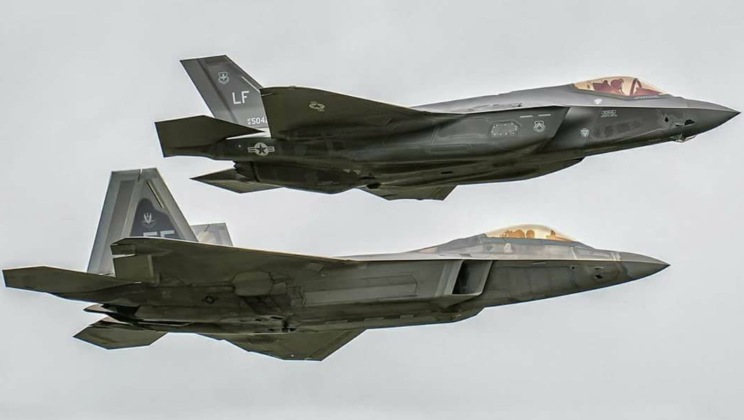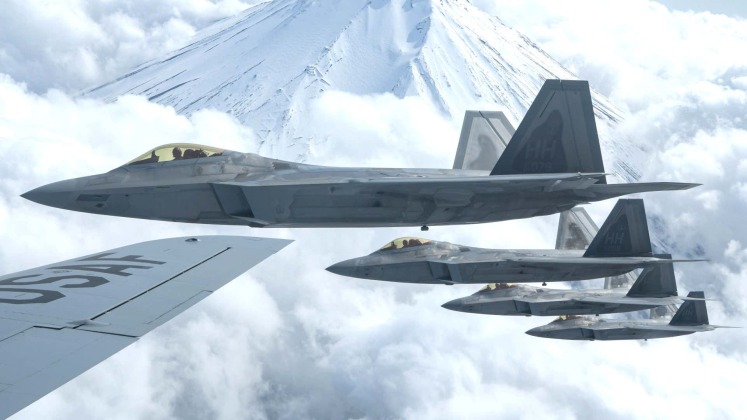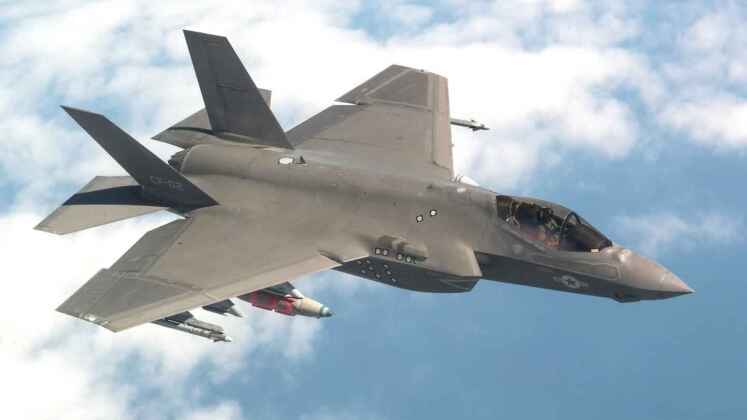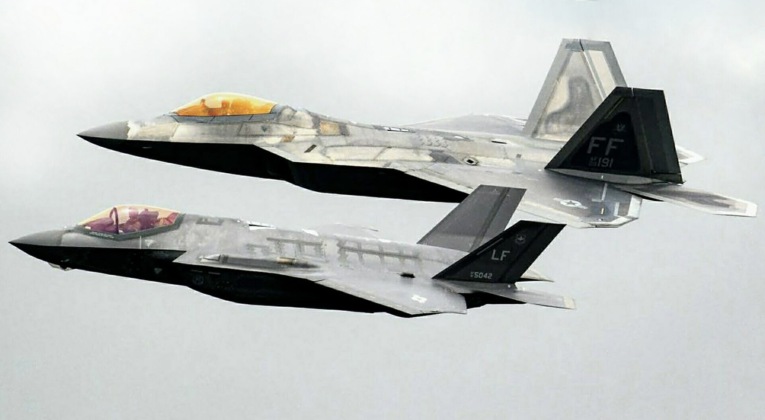The United States was for over a decade the only country in the world to deploy fifth generation fighter aircraft, with the first fighter of the generation the F-22 Raptor having entered service in December 2005 followed by the F-35 nine years later and the Chinese J-20 only from March 2017. The collapse of the USSR and termination of multiple promising fifth generation fighter programs, most notably the Su-47 and MiG 1.44, played an important role in allowing the U.S. to maintain a near monopoly in the area for several years, with the new generation defined by a number of features including radar evading stealth airframes, a new generation of avionics and electronic warfare systems and use of active rather than semi active radar guided missiles. The U.S. Military has fielded the F-22 and F-35 in complimentary but very different roles reflected by the significant differences in their designs with each having its own relative strengths and shortcomings. A comparison of the two fighters thus provides insight into how they have been designed and what the primary purposes of each fighter are.

Development of two fighters in parallel with complementary roles, one heavyweight and more costly and the other light and relatively cheap, is far from unprecedented. The F-22 as an elite heavy fighter built to engage the most advanced enemy combat aircraft is a direct successor to the F-15C Eagle and F-4E Phantom from the respective fourth and third generations, while the F-35 follows on from the F-16 Falcon and the F-5E Tiger II in fulfilling the role of a low cost and versatile light fighter capable of fulfilling any number of roles on the battlefield but specialised in none of them. The heavy air superiority fighters have been far more restricted in their exports compared to their lighter counterparts, with the F-22 banned from export entirely while lighter aircraft have been built in much larger numbers, widely exported to all manner of U.S. allies and non aligned states, and in the fourth and fifth generations also acquired in much larger numbers by the U.S. Military itself.

The F-22 was originally intended as a replacement for the F-15, with an FB-22 strike fighter variant having also been designed to replace the F-15E Strike Eagle, while the F-35 by contrast, as stressed by multiple figures in the U.S. Military leadership, was never designed for and would struggle in an air superiority role. Former Air Force chief of staff Gen. Mark Welsh stated to this effect that the F-35 “was never designed to be the next dog fighting machine. It was designed to be the multipurpose, data-integration platform that could do all kinds of things in the air-to-ground arena.. it had an air-to-air capability, but it was not intended to be an air-superiority fighter. That was the F-22.” Air Combat Command chief General Mike Hostage stated to much the same effect: “If I do not keep that F-22 fleet viable, the F-35 fleet frankly will be irrelevant. The F-35 is not built as an air superiority platform. It needs the F-22.” The F-22’s advantages include its higher operational altitude and speed, reaching Mach 2.25 and 20km high compared to the F-35’s below average speeds of Mach 1.6 and altitude ceiling of under 16km. This makes the F-35 by far the slowest modern fighter jet in the world with among the lowest altitude ceiling. Despite being 30 percent heavier, the F-22 remains far more manoeuvrable with its two F119 engines giving a respectable thrust/weight ratio of 1.08. The F-35’s single F135 engine on the other hand gives it a thrust/weight ratio of just 0.87. The F-22’s wing loading stand at just 377kg per square meter compared to the F-35’s 525kg, again demonstrating the F-22’s far superior manoeuvrability and making it better suited to combatting the elite of an enemy air force in air to air combat. The Raptor’s manoeuvrability advantage is further increased by its use of thrust vectoring engines, and it is the only Western fighter to do so.

The F-22 was designed to penetrate deep into enemy airspace and accordingly has a high endurance, although one notable shortcoming was that it failed to match the endurance of the F-15 due to its more fuel-hungry engines. The F-22 also has the ability to fly for sustained periods supersonically as previously only the Soviet MiG-31 could, and doing so without using afterburners. This was originally a requirement for an aircraft to be considered fifth generation, but was changed to accommodate the F-35 which otherwise would not have been considered part of the generation. The F-22 also benefits from a larger AN/APG-77 radar and greater firepower, with the Raptor able to carry eight air to air missiles internally where the F-35 carries a tiny payload of just four. Not only does the Raptor have more missiles, but due to its higher speed and altitude it can impart more energy onto them when firing than the F-35 can. Despite using a significantly older airframe designed in the 1980s, the F-22’s radar cross section remains significantly lower than that of its cheaper counterpart the F-35 making it far more survivable in beyond visual range combat, and leading some Western analysts to term the F-35 a ‘pseudo stealthy’ fighter.

Despite being a smaller, cheaper and lighter aircraft, the F-35 does have some important advantages over the F-22. The fighter has significantly lower maintenance requirements and a much higher combat readiness rate as a result, which can be decisive in wartime, and also benefits from lower operational costs meaning sustaining a larger fleet and ensuring high pilot training hours is made easier. Another key advantage stems from greater investments in the platform’s long term production, which allows the military to regularly apply software upgrades where they today struggle to do so for the F-22. As the F-22 is a specialised air superiority platform, it also lacks the ability to carry medium sized or heavy air to ground munitions such as the AGM-154 internally. As a result the F-22 has no nuclear strike, anti-shipping, anti-radiation or standoff air to ground capabilities while the more versatile F-35 is perfectly capable of performing in all of these roles. The F-35 also benefits from access to helmet mounted sights, a technology which Soviet fighters have used since the early 1980s but which the Raptor has yet to integrate 40 years later. This has the potential to compensate for the F-35’s vastly inferior flight performance by allowing it to engage targets with AIM-9X IR guided missiles in short range combat at far more extreme angles – while an F-22 pilot would need to point his fighter at a target to fire on them.

Although its radar is smaller, the F-35 has some advantages in situational awareness including use of an infra red search and track system which allows it to operate without any radar signature and better lock on to stealth targets, as well as a distributed aperture system allowing the pilot to see through his aircraft with external cameras which is a feature only the F-35 and China’s J-20 have. The F-35’s electronic warfare systems and avionics are over a decade ahead of the F-22 and have been updated much more frequently, which also help to heavily compensate for the disadvantages of the airframe itself. Perhaps most importantly, the F-35 has a far superior network centric warfare capability allowing it to share data with all manner of other units from warships and air defence systems to AWACS and fourth generation fighter units. The F-22, by contrast, has struggled to network with assets other than F-22s which has restricted pilots to a much more limited picture of the battlefield.

Ultimately the F-22 and F-35 are the most ambitious fighter programs in the Western world to have produced aircraft ready for combat, although the F-35 is currently restricted to a limited initial operating capability and is not yet ready for medium or high intensity engagements. The F-22 uses a much higher end more costly airframe, but has suffered from a difficulty incorporating upgrades and very high maintenance issues which along with its low production run mean it is likely to be retired from service decades ahead of the lower maintenance but more modern F-35 or even the old F-15. Although the F-22’s airframe had more potential from the outset, the handling of the program means it will eventually be comfortably superseded by the F-35 which continues to receive upgrades and new technologies while efforts to modernise the Raptor have been much more conservative. This contrasts to their predecessors the F-15 and F-16 which both received upgrades and continued to be improved in parallel, ensuring that the F-22’s predecessor the F-15 has always retained its superiority over its cheaper and lighter counterpart the F-35’s predecessor the F-16. The F-22 and F-35 are set to continue to define the fifth generation for many years to come, alongside China’s J-20 and possibly other upcoming non-Western designs. The F-35’s widespread export and massive scale of production, however, mean it will be in service for many decades to come much as the F-16 of the 1970s is still widely operated today.
